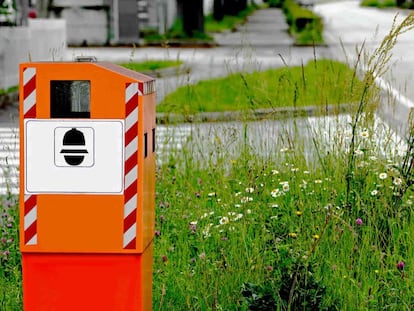The quirky Italian village where banknotes feature Maradona’s face
In Castellino del Biferno, the mayor introduced a special currency that can be used as legal tender in addition to the euro
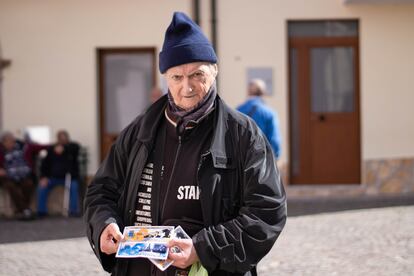
The ambiance of Castellino del Biferno is much like many southern Italian villages. A statue of St. Pius of Pietrelcina, widely known as Padre Pio, graces the entrance to the small town square, flanked by a bar on one side and a church on the other. But a closer look reveals subtle details that set it apart. A van with a map of Italy minus the northern part of the country declares, “The Rebellious South.” Stickers with the shield of the Bourbon dynasty are plastered on shop doors, harkening back to the era of the Kingdom of the Two Sicilies, the monarchy that ruled over southern Italy and Sicily from 1816 to 1861.
Castellino has around 500 residents and is three hours by car from Rome, in the center of Molise, Italy’s second-smallest region and one of the poorest. Nicola “Boss” Fratangelo can be usually found on one of the two benches near the statue of Padre Pio. Today, he sports a long black jacket and a cap over his white hair. He claims to be an advisor to Mayor Enrico Fratangelo, and clarifies they are not related, as many locals share the same last name. Fratangelo leans on a crutch to get up and shows us a few ducat bills, a local currency introduced by the town council in June 2020 that can be used as legal tender in addition to euros.
The ducat was initially introduced to replace shopping vouchers issued during Prime Minister Giuseppe Conte’s second term to support families in need during the pandemic. Fratangelo says he was inspired by Professor Giacinto Auriti, who tried a parallel currency experiment in Guardiagrele (Abruzzo) in 2000. He was also influenced by the Bretton Woods agreements of 1944, which made the U.S. dollar the global reference currency. “The biggest fraud ever,” said the mayor. “But I imitated the United States, which only had the minor cost of printing banknotes.” This is how the first ducats came about, using washable laminated paper to help prevent the spread of Covid. The bills featured symbols of local traditions and the faces of local politicos, like Fratangelo himself, who is depicted on the 20 ducat bill wearing an unbuttoned shirt and a large crucifix around his neck. “I’m thumbing my nose at the opposition,” he said.
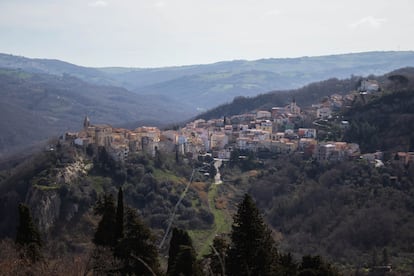
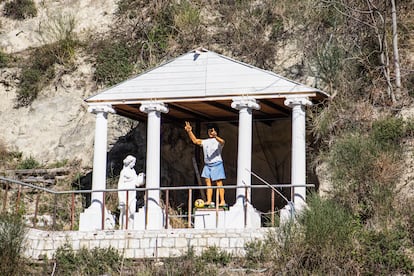
A cashier window was opened in the town hall for people to exchange euros for ducats. There was only one condition: the ducats had to be spent on specific town activities, a move aimed at stimulating the local economy. Merchants agreed to an exchange rate of €1,000 for 850 ducats to compensate for the inconvenience of accepting another currency. The Bar della piazzetta was the only business to refuse. “It’s an imposition — it forces you to stay and spend your money here. But everyone should be free to do what they want as long as we all respect each other,” said Giuseppe, the bar owner.
“Fratangelo is a dictator and a nut, but he’s a good administrator,” said Giovanni Petrucci, an 85-year-old artisan who is always in the square chatting with anyone who walks by. “He’s a good mayor, but you have to do what he says, period,” said a woman who didn’t want to tell us her name. A town councilor named Enrico “Dragon” Ferrante (he doesn’t know where the nickname comes from) doesn’t care for the ducats. “I don’t like them because you can’t use them in the post office.”
It’s been four years since the first ducats were introduced. The banknotes are regularly updated to avoid counterfeiting. Now, the focus is on incentives — recyclers can get up to 30% of their garbage disposal fee discounted if they pay in ducats.
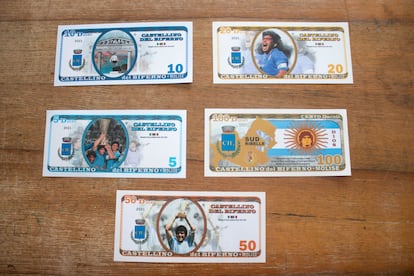
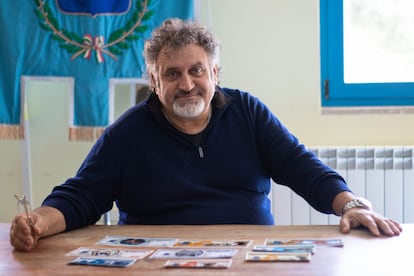
During summer, ducats are also accepted at the Olympus bar, an open-air club located upriver. It has a large swimming pool that attracts university students who are home for the summer. Something odd up on a hill catches the eye: a shrine with a life-sized statue of Argentine soccer star Diego Maradona. Fratangelo tries to explain: “The statue represents a comeuppance — think before and after Jesus Christ. Here in southern Italy and beyond, Maradona represents a before and after.”
Maradona was featured in a limited edition collection of ducats issued on February 13, 2021, to honor the victims of the Savoyard massacres in the south and the day Gaeta surrendered after a siege that defeated the Kingdom of the Two Sicilies. These special ducats are a little larger than the other banknotes and depict key moments from Maradona’s career, such as Argentina’s 1986 World Cup victory, winning the UEFA Cup when he played for Naples, and the controversial “hand of God” goal against England in the 1986 World Cup quarterfinals.
The town raised €3,000 from selling the Maradona banknotes for a charity called the “piggy bank,” which gives two ducats a day to children under the age of two, and one ducat a day to kids three to five years old. That’s about 2,550 ducats in the first year. The project aims to address demographic decline by buying and renovating 100 private houses with government funding to offer affordable homes so young people will stay in the area. “So these kids won’t go north, which is like casting pearls before swine,” said Fratangelo.
Government neglect
All the ducat banknotes bear the inscription, “Municipality of the Grand and Peaceful Ancient Kingdom of Naples. Molise County, a land of Labor and Briganti patriots. Since 1861, land of unemployment and emigration.” Castellino del Biferno was once part of the Kingdom of Naples, which later became the Kingdom of the Two Sicilies. It remained so until Italy’s unification in 1861, an event Fratangelo blames for many of the problems in southern Italy and throughout the country. “The young folks here now recognize the Bourbon flag and realize Garibaldi wasn’t exactly the big hero everyone thought. I mean, how could our 1,000 soldiers defeat an army of 27,000?“
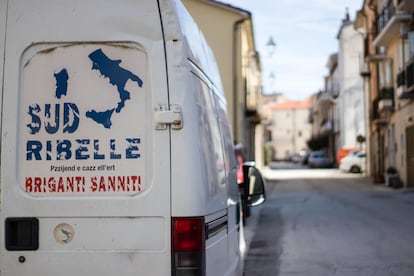
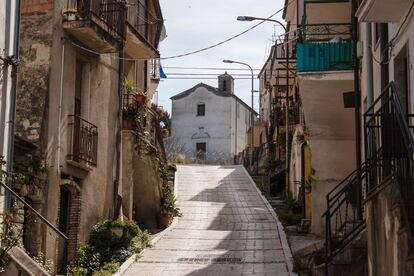
Fratangelo, who works as a nurse at Cardarelli hospital in Campobasso (20 kilometers from Castellino), has governed his town since 1997, except for 2012-2017 due to term limits. In 2002, the area was hit by the San Giuliano di Puglia earthquake, causing 30 deaths, 100 injuries, and displacing 3,000 people. Now, 22 years later, the mayor complains about the lack of government funding for rebuilding that is still ongoing.
Castellino, dubbed “the town that moves,” is situated in a high-risk area prone to frequent landslides. The fascist regime in 1930 granted the town some stable land in the upriver municipality of Petrella Tifernina, but few people moved out of Castellino. Led by Fratangelo and feeling neglected by the government, locals have formed a southern-centric political “Insurgent Movement.”
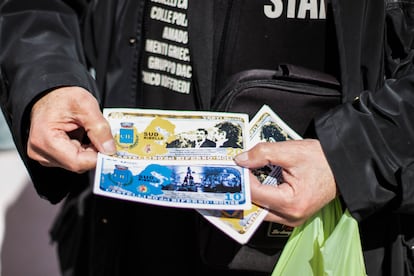
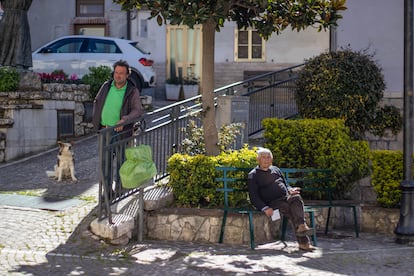
A stack of documents sits in the mayor’s office, mostly notifications about legal cases related to the ducat. Fratangelo said all the cases ended in acquittals because the Bank of Italy determined no crime occurred as the currency “simply does not exist... Italy has an oligarchy that’s even worse than Russia’s.” The mayor of Castellino del Biferno stays in touch with various independence movements in southern Italy, dreaming of a future where the south might be free again. “We need that spark to ignite, but it will happen someday.”
Sign up for our weekly newsletter to get more English-language news coverage from EL PAÍS USA Edition
Tu suscripción se está usando en otro dispositivo
¿Quieres añadir otro usuario a tu suscripción?
Si continúas leyendo en este dispositivo, no se podrá leer en el otro.
FlechaTu suscripción se está usando en otro dispositivo y solo puedes acceder a EL PAÍS desde un dispositivo a la vez.
Si quieres compartir tu cuenta, cambia tu suscripción a la modalidad Premium, así podrás añadir otro usuario. Cada uno accederá con su propia cuenta de email, lo que os permitirá personalizar vuestra experiencia en EL PAÍS.
¿Tienes una suscripción de empresa? Accede aquí para contratar más cuentas.
En el caso de no saber quién está usando tu cuenta, te recomendamos cambiar tu contraseña aquí.
Si decides continuar compartiendo tu cuenta, este mensaje se mostrará en tu dispositivo y en el de la otra persona que está usando tu cuenta de forma indefinida, afectando a tu experiencia de lectura. Puedes consultar aquí los términos y condiciones de la suscripción digital.
More information
Archived In
Últimas noticias
There is as much life left to discover on planet Earth as that which is already known
Dozens presumed dead, around 100 injured in fire at Swiss Alps bar during New Year’s celebration
Is porn for women different from conventional porn? We spoke to those who make it
Cartagena de Indias is sinking: What can the city do to mitigate it?
Most viewed
- Sinaloa Cartel war is taking its toll on Los Chapitos
- Reinhard Genzel, Nobel laureate in physics: ‘One-minute videos will never give you the truth’
- Oona Chaplin: ‘I told James Cameron that I was living in a treehouse and starting a permaculture project with a friend’
- David King, chemist: ‘There are scientists studying how to cool the planet; nobody should stop these experiments from happening’
- Why the price of coffee has skyrocketed: from Brazilian plantations to specialty coffee houses

